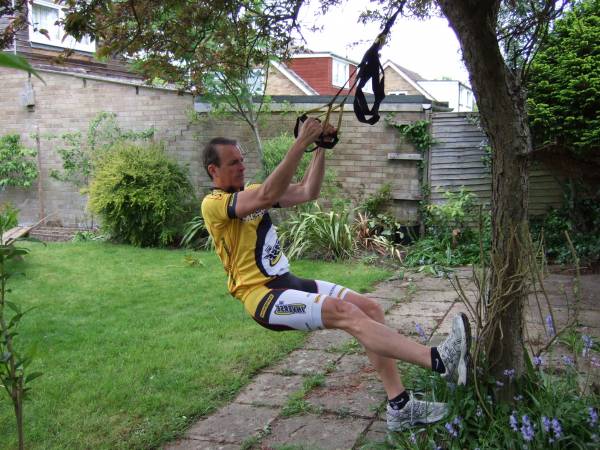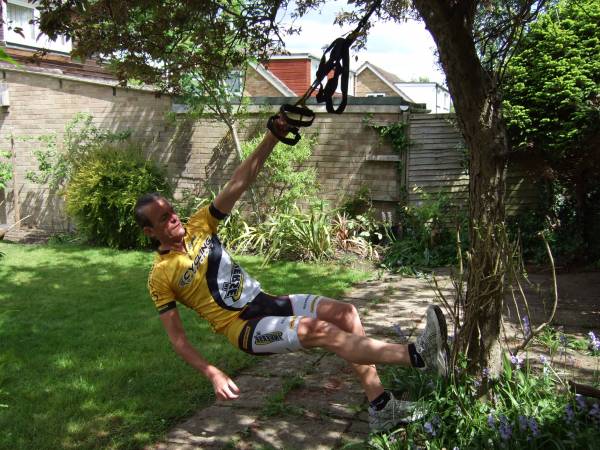Suspension trainers have been around for quite a while, and have gained popularity in recent years. This has lead to an assortment of different types on the market, from simple gym rings, to adjustable strap systems by companies like TRX.
Their simplicity and portability, requiring no more than bodyweight, makes them very versatile, and an ideal addition to the home gym. This week, I am showing you some cycling relevant exercises, which can be performed using this simple piece of equipment. These progressions are well worth putting in your training plan to improve strength, and improve power output.
A Breakdown of the Cycling Movement
To get most benefit from the exercises, the motions should be similar to the movements undertaken when riding a cycle. This ensures not only muscle development, but training of the neuromuscular pathways that activate the muscles in the correct sequence. The instability introduced by the straps of the trainers also helps emulate some of the instability of movement during cycling.
A basic breakdown of the cycling movement shows that we have three main activities:
- Hip extension with knee extension and ankle plantar flexion, in the pedal down stroke.
- Hip flexion with knee flexion and ankle dorsiflexion, in the pedal upstroke.
- Applying tension alternately with the arms to replicate pulling on the handlebars (shoulder extension with elbow flexion).
Progression 1: A Good Place to Start
The first progression is a good place to start if you are not used to working with a suspension trainer:
- Secure the suspension trainer to a sturdy anchor point that is capable of taking your whole bodyweight, and is between six and nine feet off the ground.
- Adjust the handles until they are at about shoulder height.
- Stand facing the anchor point holding both handles.
- Lean back and flex the hips and knees into a squat position.
- Push up with the legs, and as you do so, pull in on the handles slightly.
Progression 2: Closer to Cycling Motion
The second progression is a little more advanced, and is closer to the cycling motion:
- Stand facing the anchor point holding both handles.
- Lean back whilst lifting one foot off the ground slightly.
- Flex the hips and knees into a single leg squat position.
- Push up with the single leg, keeping the other foot off the ground, and as you do so, pull in on the handles slightly.

Progression 3: Replicating the Pedal Stroke
The third progression replicates the lifting one leg back onto the top of the pedal stroke:
- Stand facing the anchor point holding both handles.
- Lean back whilst lifting one foot off the ground slightly.
- Flex the hips and knees into a single leg squat position.
- Push up with the single leg.
- As you push up with the one leg, flex the opposite hip and knee to lift the foot as high as possible.
- As you do so, pull in on both handles slightly.
Progression 4: Replicating the Pull on the Handlebars
The final progression adds a single arm pull. You need to make sure that your type of training system allows you to use single handles:
- Stand facing the anchor point holding one handle, for example left side.
- Lean back whilst lifting one foot off the ground slightly, the right.
- Flex the hips and knees into a single leg squat position, on the left leg.
- Push up with the left leg.
- As you push up with the one leg, flex the right hip and knee to lift the foot as high as possible.
- As you do so, pull in on the handle slightly with the left arm.
- Swap sides and repeat with the other side, right leg and right arm.

How to Progress These Exercises
During these exercises you may find, and it is quite common, that one side is more dominant than the other. Or that one leg lifts higher than the other, or that balance is not so good on one side. It is important to reach a point where the exercise can be performed comfortably, before moving on to the next progression.
Since cycling is an endurance exercise, I would start these exercises by building them into your training regime at least three times per week, and performing three sets of ten repetitions (on each leg when appropriate). As your confidence and ability grow with each exercise, increase the number of repetitions to twenty and then thirty.
To add more power to the exercises in a second phase or period, you can increase the rate at which you perform then, eventually adding a hop or jump at the final leg extension.
References:
1. Faster Global. Diploma in Functional Training. Course notes.
Photo 1 courtesy of Shutterstock.






